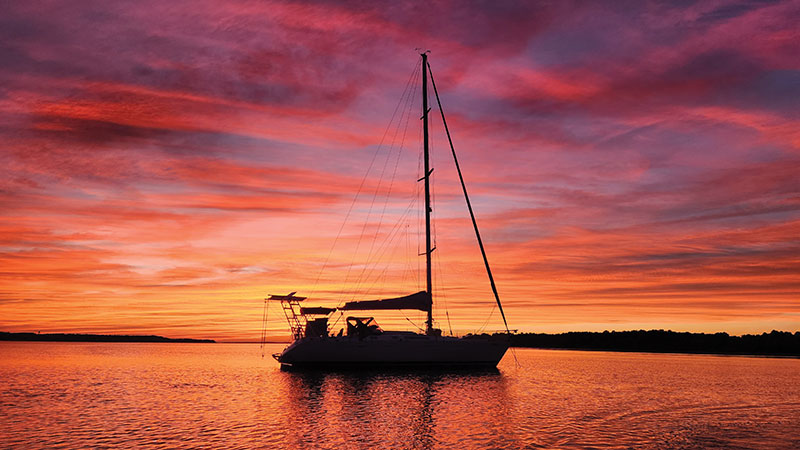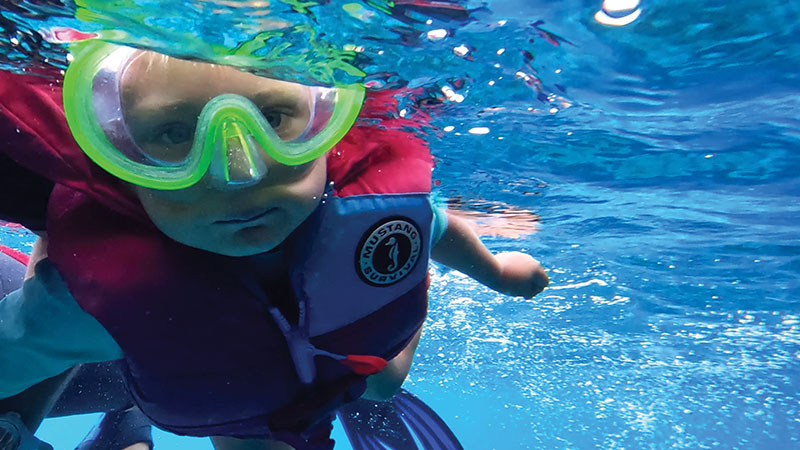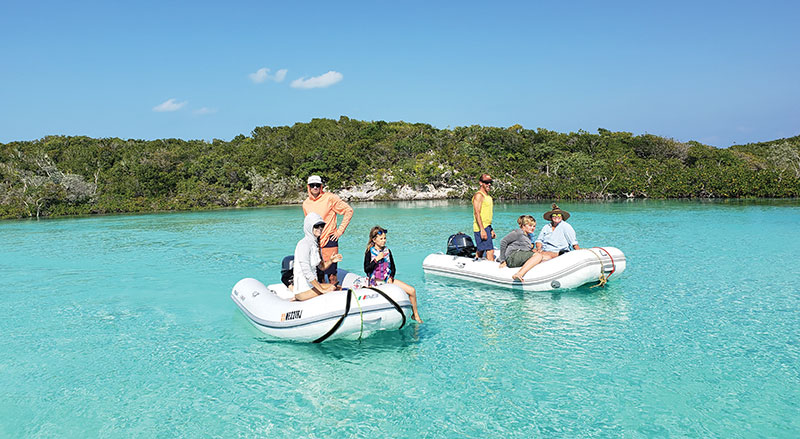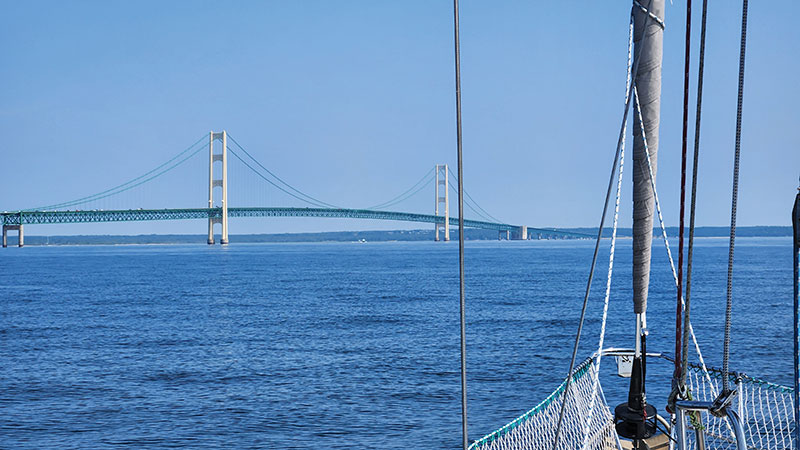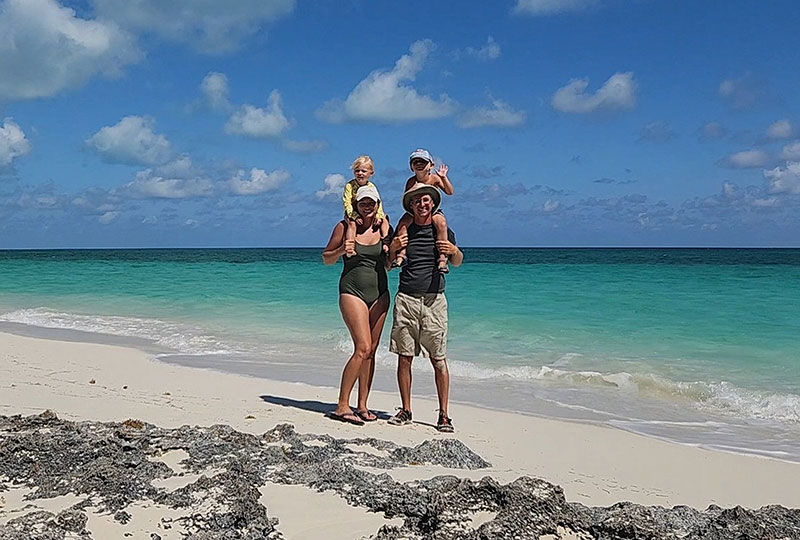
A young Michigan family, burned out from the daily grind, sails to the Caribbean in search of adventure.
At the heart of every boater is a sense of adventure — a desire to feel the rhythm of the waves beneath and to breathe in the wide open sky above. So many of us dream of distant ports, secluded anchorages and a longing for wildness. My husband and I have long dreamed of sailing to the Caribbean to find a way to separate from the daily grind of the American hustle culture. There is something so appealing about casting off and finding a new way to be in the world.
But there never seems to be a perfect time for adventure. There are myriad excuses boaters make that leave us tethered to the dock: A lack of funds, endless projects, traditional jobs, children and families, or simply a hefty dose of fear for what may befall the passengers on a grand voyage.
While we haven’t yet made the leap to cast off, we are privileged to know the captain and crew of Kasablanca, a Beneteau First 40.5, who have shown us that it’s possible to set land life aside and follow the lakes to the open sea.
Making a dream a reality
In the summer of 2022, Steve, Felicia, Vincent (3) and Clara (2) set out on an adventure of a lifetime. Leaving from Holland, Michigan, they sailed through the Great Lakes and out the Erie Canal to the Bahamas and back in a year — an incredible and important year.
When I asked them what it was like to prepare for the journey, they told me they never really committed to the trip, they simply committed to the next task or the next project that would bring them closer to being ready. They dreamt and they planned, and step-by-step they made the dream a reality. They never fully committed to a plan because they never wanted to feel like they failed if they did not go or if they turned around before they intended to; because no matter the length or the destination, the journey was necessary.
Felicia has spent her career as an emergency room nurse and the years of the pandemic were crushing her spirit. She questioned her vocation and whether or not she could continue in nursing. Steve is an engineer with a demanding job.
Feeling broken, burned out and tired, the couple listened to the pull of the sea to find freedom — to let the water and wind remind them of the beauty in the world and to show their children a life that opposes the cultural norms in America. Having made the same trip without children in 2015, the couple had some idea of what to expect as they set out.
A map of their journey from Michigan to the Bahamas
Vincent learned to snorkel at 3 years old
The “kid boat” families out on a mangrove dinghy ride on Shroud Cay, Bahamas
Finding connection
Being at the mercy of the wind and waves forces you to be in tune with your surroundings in an entirely new way. Felicia notes how aware she became of everything they consumed, every ounce of trash they produced and every gallon of water utilized. Being in a contained space, she says it’s easier to see the impacts one person can have on the world. There is a beautiful world out there that we can spoil and destroy if we aren’t thoughtful about the way we interact with the elements around us. We must be intentional about protecting the pristine waters and the creatures that live within the sea.
Throughout the trip, they spent roughly a third of their time getting to the Bahamas, a third exploring the islands and a third coming north again. The nights were often spent poring over charts and weather reports looking for the next window to move further south.
Once they were well on their way to the Bahamas, they connected with two other “kid boats,” and the families formed a connection that amplified their journeys. The three boats became a tribe that would move together, grow together and support one another along the way.
Steve and Felicia explain that it can be challenging to make genuine connections and friendships in their life on land. Perhaps life just gets in the way, and working full-time makes it difficult to find the time to pour into forming and maintaining new relationships. But on the water, they felt at ease settling into friendships. There was a common goal, shared understanding and a willingness to help each other that can be hard to find on land.
As they sailed into the pristine waters of the Bahamas, the crew unplugged further and settled in to enjoy the beauty they had spent months moving toward. The clear water led them to spend hours snorkeling and exploring beneath the waves. Vincent watched the older children in their little tribe and quickly learned to swim. He loved watching the creatures underwater. Steve was able to snag some fish while spearfishing. In this beautiful and wild place, the whole world is a bit like a playground — for the kids and adults alike.
Even though the family had arrived at their destination, it was still incredibly important to watch the weather daily; they needed to ensure they were in appropriate anchorages for the wind and wave conditions to plot their course forward hopping between islands. Each island held a new chance to explore. There were hiking trails, beaches to comb for treasures and even wild pigs! The children played in the sand while the slow pace, fresh air and sparkling water restored the adults.
Ever-changing technology played a role in many areas of their trip and helped them form connections. The couple used the No Foreign Land app to find and leave reviews of the anchorages and towns they visited. They also utilized an app that allows “kid boats” to connect with other boats with children aboard. Steve notes that having Starlink onboard was an added safety precaution as they always had access to the internet so they could obtain information if problems arose. As technology continues to expand, so does the number of liveaboards out on the water. Many people are able to work remotely from distant and remote places.
Life aboard
As I imagine the family sailing in tropical blue waters, snorkeling with colorful fish and slowing down to the pace of the wind, it’s easy to forget that life afloat also comes with the challenges of everyday life on land. They dealt with potty training, sibling conflicts, sailing through large and uncomfortable waves for 10-12 hours, seasickness and a handful of colds and fevers throughout the year. Living on a boat full-time does not solve everything. Some pressures of daily life fade away and new trials arise.
To be out there for an extended time, Steve shared that one of the most important attributes of a captain and crew is a willingness to learn new things and unending determination to solve the problems that arise along the way. Steve is a master problem solver and suggested that the best way to feel prepared is to know that you will never leave the dock if you expect to know it all before you go. There will always be things that break, problems to solve and weather to mess with the best-laid plans.
While their kids were young on their journey and may not have concrete memories of the year afloat, Vincent and Clara were marked by this adventure. Their parents instilled in them an idea of what is possible and showed them a world that is broader than their neighborhood. They are capable and strong, flexible and engaging children who have an innate sense of wonder. The children remember the friends they made along the way and verbalize a desire to live on the boat again some day. Was it ideal to leave the dock with kids in diapers? Probably not. But it was also not a reason to set the dream aside.
“The highs are much, much higher,” Felicia says, “but the lows are the same.”
They had a strong desire to listen to the pull of the sea and find much needed grounding where there was no ground beneath them. They could have found unending reasons not to go, but they knew the importance of the journey.
Returning home
When the family returned, they had to recalibrate to life on land. The boat felt like home even though they were technically back “home” in their house. They felt far from each other as they slept in different bedrooms instead of snug in their berths. The ease of using a car to get groceries felt like a luxury. Consumerism and waste were apparent in new ways. Through it all, they became more in tune with the world and with each other. They returned more patient.
Steve and Felicia both felt that the year was worthwhile in every way. They don’t know when their next voyage will take place, but the idea and the desire is there.
Perhaps there will be a time in life that presents itself and feels just right for adventure, but I think it’s more likely that there will forever be something that can stand in the way if we let it. Perhaps the best way to find ourselves in wild spaces is to do just as the crew of Kasablanca did — create a plan and slowly take one step toward the dream until it becomes a reality. May their story awaken all of our spirits to adventure, for our souls sense the adventure that awaits.
Clara with the famous beach pigs on Big Majors Point, Staniel Cay Bahamas
Beach time with “kid boat” families in Georgetown, Bahamas
Passing the Mackinac Bridge


